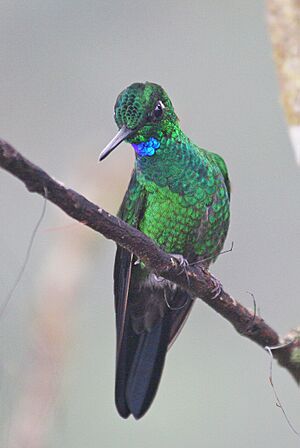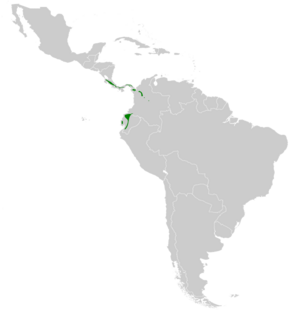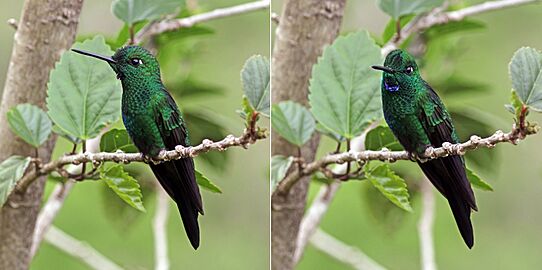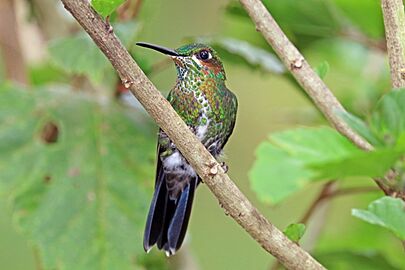Green-crowned brilliant facts for kids
Quick facts for kids Green-crowned brilliant |
|
|---|---|
 |
|
| Male | |
 |
|
| Female Both in Mount Totumas cloud forest, Panama |
|
| Conservation status | |
| Scientific classification | |
| Genus: |
Heliodoxa
|
| Species: |
jacula
|
 |
|
| Range of H. jacula | |
The green-crowned brilliant (Heliodoxa jacula) is a type of hummingbird known for its bright colors. It belongs to a group of hummingbirds called "brilliants." You can find this bird in countries like Colombia, Costa Rica, Ecuador, and Panama. Sometimes, people also call it the green-fronted brilliant.
Contents
About the Green-Crowned Brilliant
The green-crowned brilliant has three main types, or subspecies. These are H. j. jacula, H. j. henryi, and H. j. jamersoni. They are all very similar but have small differences in size or color.
What Does the Green-Crowned Brilliant Look Like?
Male green-crowned brilliants are about 12 to 13 centimeters (about 5 inches) long. Females are a bit smaller, around 10.5 to 12 centimeters (about 4.5 inches). Both male and female birds have a white spot behind their eye. They also have a tail that looks forked, like a "V" shape. The male's tail is more deeply forked than the female's.
Male and Female Differences
Adult males of the most common type (H. j. jacula) have a super shiny, bright green to blue-green head and chest. They also have a small, sparkly violet-blue patch on their throat. Their upper body and belly are a bronze-green color, and their tail is blue-black.
Female birds of this type have a blue-green head, but it's not as shiny as the male's. They have a short white stripe on their cheek. Their underparts are whitish with many green spots. The outer feathers of their tail have white tips.
Young Green-Crowned Brilliants
Young males have a duller bronze-green head and underparts. They have a bright, light yellow-brown chin and cheek stripe. Their tail is not as deeply forked. Young females have a bright, light yellow-brown throat and duller green spots on their underparts compared to adult females.
Subspecies Variations
The H. j. henryi subspecies is larger than the common type. Males of this group have an even brighter head and more green feathers. Females have more white on their underparts. The H. j. jamersoni males are duller on the head and chest. Their tail is shorter and has a green shine.
Where Do Green-Crowned Brilliants Live?
The common subspecies, H. j. jacula, lives in eastern Panama and throughout Colombia's mountain ranges. The H. j. henryi subspecies is found further north, from Costa Rica down into Panama. The H. j. jamersoni subspecies lives along the western side of the Andes mountains in Colombia and Ecuador.
These hummingbirds live in many different places. They like humid (damp) mountain forests, both inside the forest and along its edges. They also live in older secondary forest (forest that has grown back after being cut down) and even in gardens. They usually live at elevations between 700 and 2200 meters (about 2,300 to 7,200 feet) in Costa Rica. In other countries, they can be found at slightly different heights.
Green-Crowned Brilliant Behavior
Movement
Sometimes, green-crowned brilliants are seen at lower elevations. This might mean they move to different areas depending on the season.
Feeding Habits
The green-crowned brilliant usually looks for food in the middle and upper parts of the forest. They love to drink nectar from Marcgravia vines. Females also feed from smaller plants closer to the ground. Male birds sometimes protect patches of Marcgravia flowers. However, they also "trap-line," which means they visit a regular path of flowering plants. These birds usually hold onto flowers while they feed, instead of just hovering.
Reproduction and Life Cycle
In Costa Rica, green-crowned brilliants are thought to nest from July or August to January. In Colombia, their nesting season is from May to September. Their nest is a bulky cup made of plant fibers and pieces of tree ferns. They build it on a thin, downward-sloping branch, usually about 2 to 6 meters (about 6 to 20 feet) above the ground. The female bird alone sits on the two white, oval-shaped eggs to keep them warm.
Vocalization
The green-crowned brilliant makes a loud, squeaky "kyew" or "tyew" call. When males are showing off, they make a "tseek, tseek, tseek" sound. If they are chasing each other, they make loud sputtering noises and squeaks.
Conservation Status
The IUCN (International Union for Conservation of Nature) has listed the green-crowned brilliant as a species of "Least Concern." This means that, for now, they are not considered to be in danger of disappearing. However, we don't know exactly how many of these birds there are, and their numbers are thought to be slowly decreasing. While they can handle some changes to their habitat, clearing away entire forests is expected to cause their numbers to drop in those areas.
Gallery




